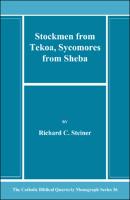Please use this identifier to cite or link to this item:
https://hdl.handle.net/20.500.12202/8701| Title: | Stockmen from Tekoa, sycomores from Sheba: A study of Amos’ occupations |
| Authors: | Steiner, Richard C. |
| Keywords: | Amos (Biblical prophet) sycomore horticulture lexicographic controversies archaeology botany |
| Issue Date: | 2003 |
| Publisher: | Catholic Biblical Association (CBA) |
| Citation: | Steiner, R. C. (2003). Stockmen from Tekoa, sycomores from Sheba : a study of Amos’ occupations (1st ed.). Catholic Biblical Association of America. https://epdf.pub/stockmen-from-tekoa-sycomores-from-sheba-a-study-of-amos-occupations-the-catholi.html |
| Series/Report no.: | Catholic Biblical quarterly;Monograph series 36 |
| Abstract: | Amos is viewed by many as a pivotal figure in the history of prophetism, in part because he worked for a living before his call instead of training to become a prophet. But what precisely was his occupation? The question has been discussed time and again in biblical scholarship, for “it is believed that as his sociocultural background is grasped or reconstructed we have a key, if not the key, to his message.” 1¶ The question ought to be easy to answer. After all, three verses of the book of Amos deal with the question. Biblical scholars are accustomed to making do with far less! In truth, the question “seems quite complex.”2 According to a scholar who devoted a good part of his career to just one of Amos’ occupations, the answer requires input from the fields of botany, zoology, genetics, philology, Talmud, and Egyptology, not to mention Bible!3 Just reading the literature on the subject is a daunting task....¶ In this monograph I shall address these problems and others. I shall delve deeply into the practice of sycomore horticulture, sycomore silviculture and animal husbandry. I shall attempt to resolve the lexicographic controversies using the resources of Akkadian, Mishnaic Hebrew, Yemeni Arabic, etc. The resolution of these controversies will prove to have significance beyond the confines of Hebrew philology, biblical criticism, the history of prophetism, and the history of agriculture. Specifically, I shall attempt to show that our results shed light on the origin of the biblical sycomore—a problem that has generated much controversy among archeobotanists and paleobotanists—and the Arabian trade that began in the Late Bronze Age. In view of the complexity of the issues, the reader who does not prefer to be kept in suspense may wish to read the summary of conclusions at the end before becoming immersed in the details. Finally, a word about my use of the spelling “sycomore” instead of the more common “sycamore.” Both forms are used popularly to designate Ficus sycomorus L.,6 a relative of the common fig tree also known as “sycamore/sycomore fig,” “mulberry fig,” “fig-mulberry,” “Egyptian fig,” “pharaoh’s fig,” “wild fig,” “cluster fig,” and “ass fig (Eselsfeige).” Unfortunately, the name “sycamore” is applied to unrelated trees in America and England. To avoid confusion, some botanists in recent years have recommended using the spelling “sycomore” for Ficus sycomorus and reserving “sycamore” for Platanus 6 (From Introduction). |
| Description: | Scholarly work |
| URI: | https://epdf.pub/stockmen-from-tekoa-sycomores-from-sheba-a-study-of-amos-occupations-the-catholi.html https://hdl.handle.net/20.500.12202/8701 |
| ISSN: | 0008-7912 |
| Appears in Collections: | Bernard Revel Graduate School of Jewish Studies (BRGS): Faculty Publications |
Files in This Item:
| File | Description | Size | Format | |
|---|---|---|---|---|
| Richard Steiner Stockmen from Tekoah OA 20Feb2023.pdf | 740.65 kB | Adobe PDF |  View/Open |
This item is licensed under a Creative Commons License

